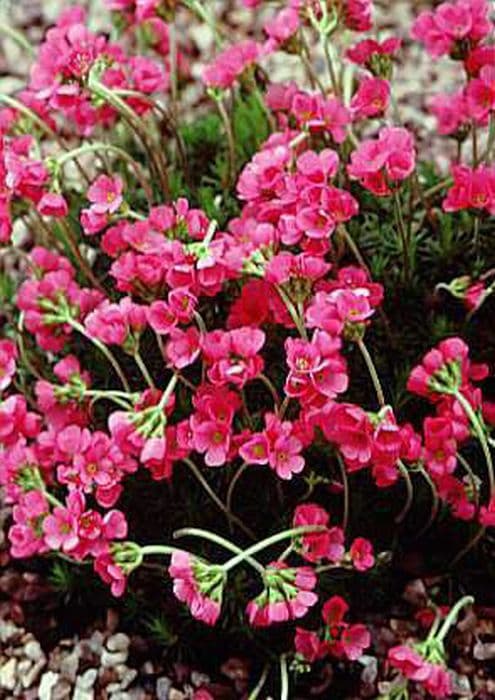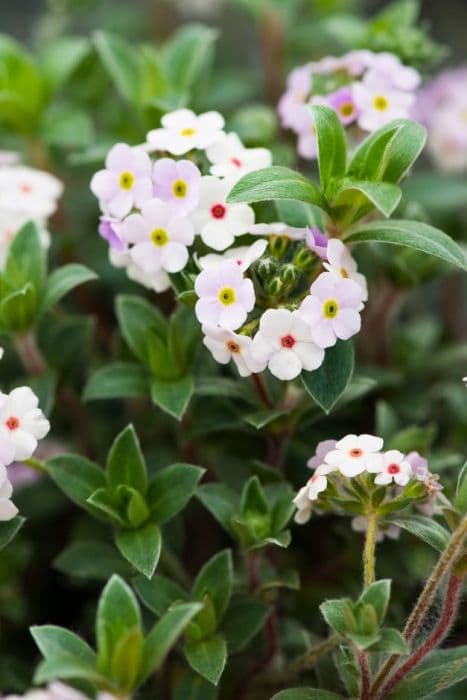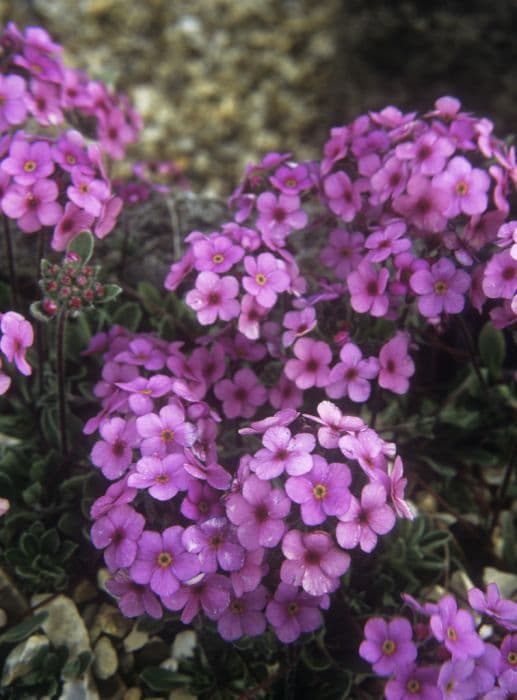Bear's ear Primula auricula 'Forest Sunlight' (Au/d)

ABOUT
The plant known as 'Forest Sunlight', belonging to the auricula group, boasts a dazzling display of flowers and foliage that capture the attention of onlookers. Its flowers possess a unique charm, typically featuring a rich, vibrant yellow hue that may evoke the warmth and glow of sunlight dappling through a forest canopy. Each petal can be round to oval, sometimes with a velvety texture that further enhances the plant's visual appeal. To complement the striking flowers, the leaves of 'Forest Sunlight' present in a lush, earthy green color that provides a perfect backdrop to the bright blossoms. The foliage exhibits a somewhat fleshy and succulent texture, which further underscores the plant's robust nature. These leaves are often arranged in a rosette pattern, spreading outwards from the center of the plant and creating a pleasing symmetrical form. Overall, 'Forest Sunlight' is celebrated for its ornamental beauty, with its cheerful flowers and substantial greenery making it a popular choice among gardeners and plant enthusiasts. It can add a touch of forest-inspired enchantment to any garden setting, container, or display where its characteristics can be fully appreciated.
About this plant
 Names
NamesFamily
Primulaceae
Synonyms
Bear's Ear, Mountain Cowslip, Auricula
Common names
Primula auricula 'Forest Sunlight' (Au/d).
 Toxicity
ToxicityTo humans
The Primula auricula, commonly known as Auricula, is not considered highly toxic to humans. However, handling the plant may cause skin irritation due to the presence of Primin, which can be found in the foliage and sap. Ingesting parts of the plant might result in mild gastrointestinal discomfort, such as nausea or stomach pain. It is advisable to wear gloves while handling and to keep the plant out of reach of children who might accidentally ingest it.
To pets
The Auricula is generally not considered highly toxic to pets such as dogs and cats. Nonetheless, as with humans, the presence of Primin in the foliage and sap can cause mild dermatitis or skin irritation if pets come into contact with the plant. If a pet ingests Auricula, they might experience mild gastrointestinal upset, leading to symptoms such as drooling, nausea, vomiting, or diarrhea. It's recommended to prevent pets from ingesting the plant and to seek veterinary care if any worrying symptoms occur.
 Characteristics
CharacteristicsLife cycle
Perennials
Foliage type
Evergreen
Color of leaves
Green
Flower color
Yellow
Height
6 inches (15 cm)
Spread
6 inches (15 cm)
Plant type
Herb
Hardiness zones
5
Native area
Europe
Benefits
 General Benefits
General Benefits- Attractive Flowers: Primula auricula 'Forest Sunlight' showcases vibrant flowers that add aesthetic appeal to gardens and landscapes.
- Compact Size: Its small stature makes it suitable for rock gardens, container plantings, and spaces with limited room.
- Spring Blossom: Blooms in the early spring, providing one of the first bursts of color after the winter season.
- Low Maintenance: Once established, it requires minimal care, making it a good option for busy gardeners or those new to horticulture.
- Attracts Wildlife: The flowers can attract pollinators such as bees and butterflies, supporting local ecosystems.
- Hardy Plant: It is quite hardy and can tolerate colder temperatures, which makes it a good choice for gardens in cooler climates.
- Drought Tolerance: Once established, it has a degree of drought tolerance, reducing the need for frequent watering.
- Versatile Planting Options: Can be planted in a variety of soil types and conditions, provided they are well-draining.
- Hybrid Vigor: As a hybrid variety, it may exhibit greater resilience and vigor compared to some pure species.
- Edging Plant: Its clumping growth habit makes it an excellent choice for borders and edging in garden design.
 Medical Properties
Medical PropertiesThis plant is not used for medical purposes.
 Air-purifying Qualities
Air-purifying QualitiesThis plant is not specifically known for air purifying qualities.
 Other Uses
Other Uses- Auricula Theatre Display: Collectors of Primula auricula often display their prized specimens in a tiered arrangement known as an auricula theatre, which is a unique way to show off these plants in organized, decorative fashion.
- Photography: Because of their colorful and intricate flowers, Auriculas make great subjects for botanical photography, especially when capturing the detail of their petals and patterns.
- Art Inspiration: The beauty and variety of auricula flowers can inspire watercolor artists, illustrators, and other visual artists to create artwork based on their forms and colors.
- Horticultural Shows: Gardeners may use Auriculas as entries in horticultural competitions or flower shows due to their striking appearance and the challenge they present in cultivation.
- Educational Tools: Botany enthusiasts can use Auriculas to teach about plant genetics and hybridization due to the vast array of available hybrids and their diverse characteristics.
- Dried Flower Arrangements: The flowers can be dried and used in potpourri or as part of a dried flower arrangement, adding a touch of natural beauty that lasts.
- Collectors' Exchange: Enthusiasts often engage in the exchange or trading of Auricula seeds or offsets, cultivating a community and culture around these plants.
- Craft Projects: The distinctive shape of auricula flowers can be used in craft projects as stencils or designs, such as in fabric printing or paper crafts.
- Theme Gardens: Auriculas can be incorporated into themed garden displays that focus on Alpine plants or specific color schemes due to their mountainous origins and vivid hues.
- Decorative Pots: Growing Auriculas in ornate pots can enhance their aesthetic appeal, making them standout decorative elements for patios, balconies, and garden tables.
Interesting Facts
 Feng Shui
Feng ShuiThe Auricula is not used in Feng Shui practice.
 Zodiac Sign Compitability
Zodiac Sign CompitabilityThe Auricula is not used in astrology practice.
 Plant Symbolism
Plant Symbolism- Rare and Unique: The Primula auricula, also known as 'Bear's Ear', is often associated with rarity and uniqueness due to its distinct shape and varied color patterns, conveying a message of individuality.
- Delicateness and Sensitivity: As a delicate-looking flower, the Bear's Ear symbolizes sensitivity and a need for careful handling, much like the tender emotions it may represent.
- Hope and New Beginnings: Blooming in early spring, the Bear's Ear often signifies hope, renewal, and the joy of new beginnings.
- Patience and Perseverance: The Bear's Ear is noted for its ability to thrive in alpine environments, symbolizing patience and the ability to persist through hard conditions.
 Water
WaterAuriculas should be watered carefully to avoid waterlogging the soil and rotting the roots. Water the 'Forest Sunlight' auricula when the soil surface feels dry, roughly once a week, with more frequent watering required during hot, dry periods. Provide the plant with about one gallon of water per watering session to ensure even soil moisture. During the winter or in cooler temperatures, reduce watering to avoid soggy soil, as the plant requires less moisture when it's not in active growth. Always check the top inch of soil for dryness before watering again.
 Light
LightAuriculas, including the 'Forest Sunlight' variety, prefer bright, indirect sunlight to thrive. The best spot for this plant would be a location where it receives morning light and afternoon shade, avoiding the strong midday sun which can scorch the leaves. A north-facing window or a shaded part of a garden with dappled sunlight is ideal for keeping the 'Forest Sunlight' auricula healthy.
 Temperature
TemperatureAuriculas like 'Forest Sunlight' do best in cool to moderate temperature conditions. Ideally, they prefer a range between 50-70 degrees Fahrenheit, which encourages robust growth and flowering. While they can survive temperatures as low as 40 degrees Fahrenheit, they should be protected from frost. They're not suited for high heat, with temperatures above 80 degrees Fahrenheit potentially causing stress to the plant.
 Pruning
PruningPruning 'Forest Sunlight' auriculas is mainly done to remove dead or fading flowers and encourage more blooms. Deadheading, or the process of cutting off spent flowers, should be done regularly during the blooming season to maintain a neat appearance and promote continuous flowering. Prune away any dead or diseased foliage as needed throughout the year. The best time for pruning is immediately after the main flowering period has ended.
 Cleaning
CleaningAs needed
 Soil
SoilAuricula, commonly known as Bear's Ear, thrives in well-draining, slightly alkaline to neutral soil with a pH range of 6.0-7.5. A good mix would consist of one part loam, one part peat-free compost, and one part perlite or grit for improved drainage.
 Repotting
RepottingBear's Ear should be repotted every one to two years, preferably in late summer after flowering or in early spring before the onset of new growth. This ensures that the plant remains in fresh soil and has room to grow.
 Humidity & Misting
Humidity & MistingThe preferred humidity range for Bear's Ear is moderate, typically around 50-60%. They enjoy a moist atmosphere but do not tolerate excessively damp conditions which can lead to rot.
 Suitable locations
Suitable locationsIndoor
Keep Bear's Ear in bright, indirect light, with cool temps, and moderate humidity.
Outdoor
Place Bear's Ear in partial shade, shelter from intense sun and heavy rain.
Hardiness zone
4-8 USDA
 Life cycle
Life cycleThe life cycle of Primula auricula 'Forest Sunlight', commonly known as Auricula, begins with germination, where seeds develop into small seedlings under appropriate moisture and light conditions. These seedlings then grow into rosettes of leaves close to the soil in their juvenile phase. With maturity, the plant produces flowering stalks adorned with clusters of bright yellow, fragrant flowers typically in early to late spring. After pollination, typically by insects, the flowers develop into capsules containing numerous tiny seeds. These seeds can be dispersed by wind or water, or by adhering to animals, leading to the germination of new plants. The Auricula is a perennial, which means it can live for several years, going dormant in winter and re-emerging in spring to repeat the cycle.
 Propogation
PropogationPropogation time
Spring
Propogation: The most popular method of propagating the Primula auricula 'Forest Sunlight', commonly known as Auricula Primrose, is by division. This is best done in late summer after the flowering period has ended. To propagate by division, gently lift the plant from the soil and carefully separate the rosettes, ensuring that each division has roots attached. These divisions should then be replanted into pots using a mix of potting soil and perlite or into well-draining garden soil. Water the new plants and keep them in a shaded area until they establish, which typically takes a few weeks. This process is relatively straightforward and allows the gardener to create new plants that are genetically identical to the parent, maintaining the unique characteristics of 'Forest Sunlight'.









